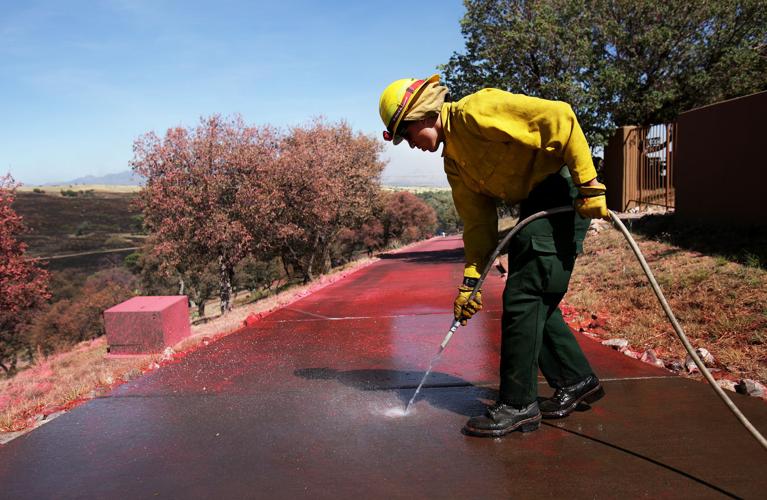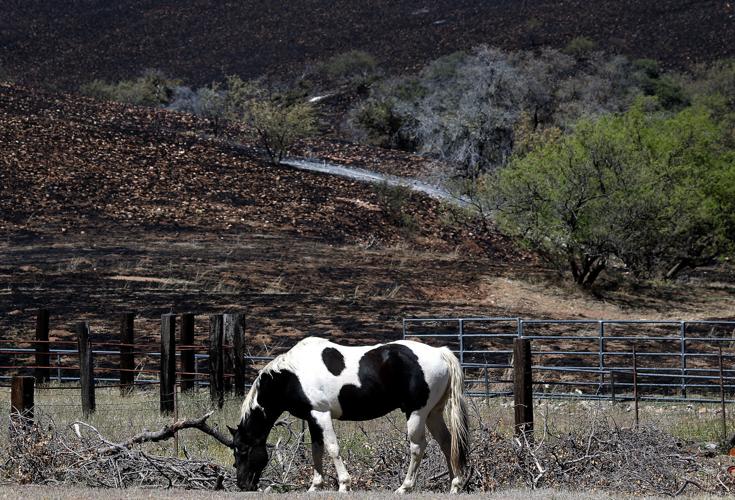The Sawmill Fire burning southeast of Tucson was at 40,356 acres late Wednesday, with wind gusts Thursday in the area expected to hit up to 35 mph.
And on Friday, the windy conditions are expected to continue with gusts up to 45 mph because of a storm that will pass through the burning area on into New Mexico, said Carl Cerniglia, a National Weather Service meteorologist in Tucson.
The wind conditions expected Friday afternoon may cause the grounding of aircraft — as it did on Tuesday because the wind made slurry drops ineffective.
The fire was 20 percent contained Wednesday night and 606 firefighting personnel from multiple agencies were battling the blaze, which is believed to be human-caused although authorities won’t say more about that investigation.
There are seven helicopters and three fixed-wing aircraft assigned to the operation, said Manny Cordova, a fire incident management team spokesman. No structures have been lost that they know of, and there have been no reports of injuries, but homes and ranches remain at risk and the blaze downed power lines, he said.
Hundreds of residences, primarily in rural areas west of Benson and south of Interstate 10 and Mescal remain under pre-evacuation orders, said Carol Capas, a Cochise County sheriff’s spokeswoman. The blaze was about 12 miles from the community of J-6 Ranch, she said.
“We will have fire crews in the Mescal area working through the night,” said Cordova.
The Cochise County Sheriff’s Office said a “demarcation line” has been set about six miles southwest of J-6 and if the fire reaches that line, residents will be ordered out immediately.
Cochise County is opening an emergency operations center at 6 a.m. Thursday in Bisbee, which will be manned 24 hours a day to support first-responders in the field and residents, Capas said.
Homeowners were allowed to return to their homes in the Singing Valley and Greaterville areas Wednesday after being evacuated Monday.
One of the homeowners, Bryce Reichardt, posted on Facebook: “We’re back home. All 11 houses in the neighborhood escaped the flames and everyone is fine. Most of the wood fences are gone.
“Thankfully, most of the trees survived since grass fires move so quickly. Our biggest problem is the house is covered with slurry,” he wrote, adding that a crew from the Sonoita-Elgin Fire District washed the slurry off his house, which is in the Singing Valley area near Sonoita.
The blaze is burning through vegetation boosted by the wet monsoon season last summer, according to a weather service tweet. The weather service also said the scar left from the fire can be seen by satellite from space.
Arizona 83 in the fire area remained closed to public traffic, but the closure area was reduced. The highway is now closed from about five miles north of Sonoita to about 11 miles south of Interstate 10, says the Arizona Department of Transportation.
While the fire has grown, calmer winds allowed crews Wednesday to complete structure protection efforts in the communities of Hilton Ranch and J-6 Ranch. Crews were also prioritizing structure protection efforts in Rain Valley, which was evacuated, and the Empire Ranch area, officials said.
The Empire Ranch Foundation posted photos on Facebook showing historic buildings were spared, although rolling grassland around them was scorched by the fire at the circa-1880 ranch. The Empire Ranch, listed on the National Register of Historic Places, is 10 miles north of Sonoita and 50 miles southeast of Tucson in Las Cienegas National Conservation Area.
The fire started Sunday south of Green Valley near Madera Canyon and blew northeastward across the northern foothills of the Santa Rita Mountains.





